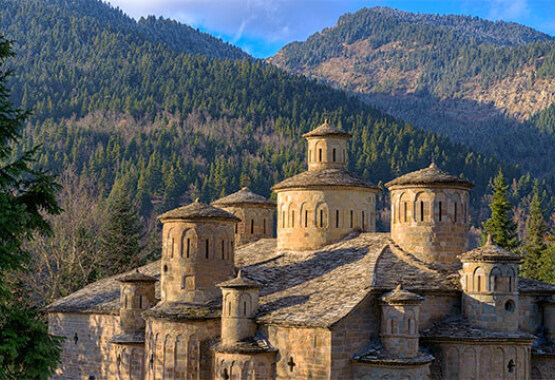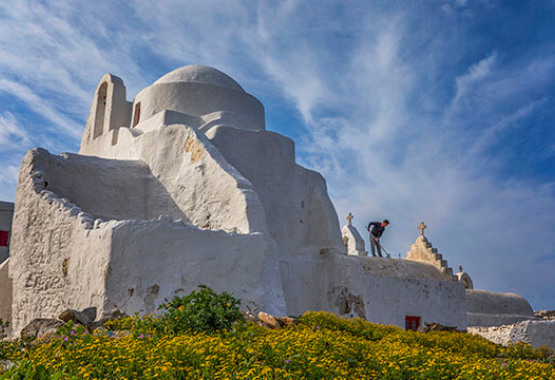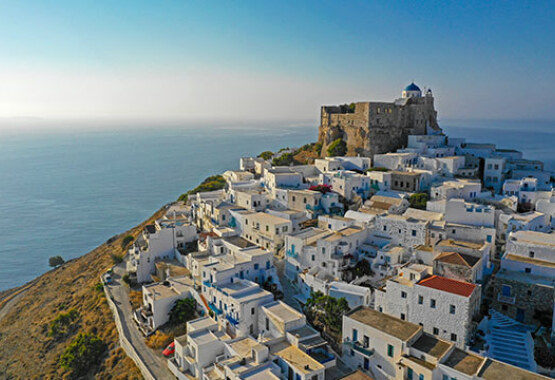The villages of Grevena
Virgin forests and stone-built villages
The natural environment of the Grevena area is incredibly diverse and does not fail to impress the most demanding visitor. The journey from Samarina to the peaks of North Pindos Range, towards Deskati and the banks of Aliakmonas River will offer you marvellous views of the wonderful works of nature as well as of the eye-catching man-made creations.
The Valia Calda National Park is one of the most impressive and pristine forests in Greece. It is located in the North Pindos mountain range bordering the regional unit of Ioannina and its name in the Vlach dialect means “warm valley" in what apparently is a tongue-in-cheek description of an area that is characterised by very low temperatures and high humidity.
The protected area covers 6,900 hectares and hosts a significant number of species of Greek fauna and flora, among them the rare brown bear. It is crossed by many small streams, the main one being the Arkoudorema, while dense forests, mainly pine and beech, cover the largest part of the area. The forest park has several routes - some of which need a 4x4 vehicle or an experienced driver - and attract many nature-lovers every year. The Krania Grevenon - Mikrolivado route through magnificent scenery of the forest park leads to the traditional Vlach villages of Avdella and Perivoli.
To the west of Grevena, many of the villages scaling the slopes of North Pindos are living museums displaying the traditional craftsmanship of stone masons, or "koudareioi" from kouda, which means stone. Two-storey and three-storey houses built more than 150 years ago still stand proudly, testifying to past wealth but also the technical knowhow of a bygone era. Agios Kosmas, Kalloni, Kydonies, Trikorfo, Dotsiko and the neighbouring villages, known as Mastorochoria (stonemaster villages) of Grevena, were the homeland of famed craftsmen, who travelled in groups, like their Epirus counterparts, many months a year, building houses all over Greece, and often beyond. A little further south, traditional villages such as Spilaio, Ziakas, Lavdas, Alatopetra, Prosvoro and Aetia, Smixi and the famous Samarina, are all worth visiting, either in the summer, when they are buzzing with life, or in winter, as they are close to the route leading to the ski centre of Vasilitsa.
It takes less than 30 minutes to reach Kydonies, one of the most beautiful Mastorochoria of Grevena, with the impressive church of Agios Athanasios, the old stone-built school, which now houses the folk art museum of the village, but also its fountain, work of the great master stone mason Vraga. It has very few residents in the winter, but comes to life during the summer months.
Kalloni is a few kilometres away and is reached via not particularly difficult asphalt roads. Situated at an altitude over 1,000 metres, it has a picturesque square and is graced by the imposing church of Agios Nikolaos and its intricately crafted icon screen. Its many two-and three-storey stone houses are based on Macedonian archetypes with some having Ottoman influences.
The 10-km route to Dotsiko, perhaps the most lively village in the area during the winter, promises splendid landscapes, as well as meetings with herds of wild horses.
There are also stone houses, as well as quaint tavernas with local grills and mezedes (titbits). The village sight is the stone bridge at its centre.
Just 20 kilometres separate Dotsiko from Samarina, the most famous Vlach village. Built on the slopes of Mt. Smolikas, at an altitude of almost 1,600 metres, Samarina claims the title of the highest village in Greece, and of the Balkans. Tidy and clean with cobbled streets and hospitable inhabitants, it welcomes visitors all year round.
The route of about 25 km from Grevena to Spilaio affords views of forested landscapes, ravines, steep cliffs and bridges. Among the very old villages of the area, Spilaio caters to a variety of activities, from hiking to extreme sports.
Other villages of note include picturesque Ziakas and its bridge of the same name. Lavda, at an elevation of 1,100 metres on the slopes of Mt. Orliakas, which looks east to Mt Olympus and west to Mt Smolikas, is known for its Mushroom Museum.
Alatopetra is built in an oak forest of exceptional natural beauty, which includes a 35-metre-high waterfall. The village also has historical significance as it borders the archeological site of Kastri.
Also located in an oak forest, Prosvoro, at an altitude of 1,000 metres, has incredibly hospitable residents, eager to tell you stories from the past.
The town of Deskati and the beautiful church of Saints Constantine and Helen in the main square is at the opposite end of the Grevena regional unit.
On your way to Kozani, you will see some very impressive geological formations, called Boucharia and Nochtaria, 3 to 7 metres high, created by the soil erosion which started in the area about 70,000 years ago.




